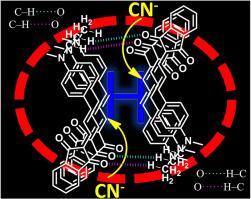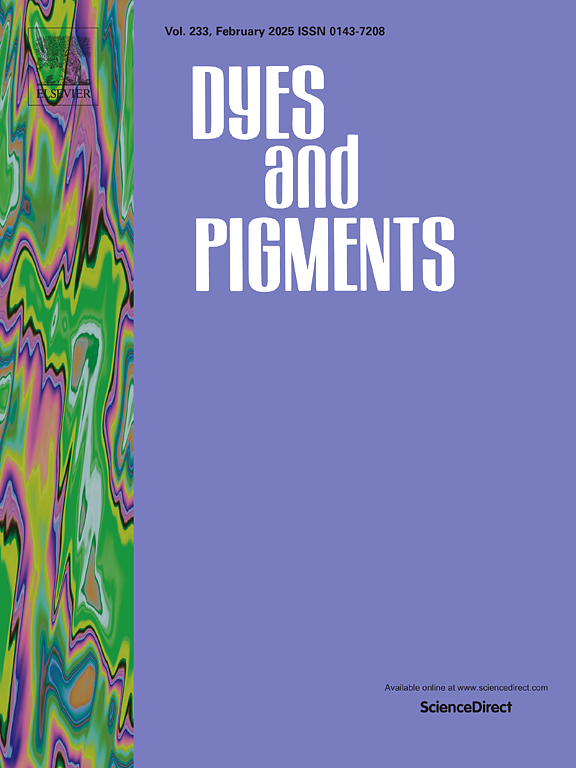分子间C-H⋯O氢键诱导的h聚集体用于快速、实时检测氰化物
IF 4.1
3区 工程技术
Q2 CHEMISTRY, APPLIED
引用次数: 0
摘要
一种专门的化学剂量计H1包含一个固体红色荧光团,该荧光团由近平面的二甲基苯胺-茚二酮缀合物形成,利用分子内电荷转移(ICT)机制设计用于氰化物检测。化学剂量计H1在极性有机溶剂中显示出强烈的ict诱导发射,尽管其荧光在固态中减弱。与具有类似二甲基苯胺-茚二酮共轭结构的j聚集固体红色荧光团J1相比,具有扩展乙烯基共轭的化学剂量计H1在固态下显示出相对弱的蓝移红发射,这是由于分子间C-H⋯O氢键诱导形成h聚集。氰化物与化学剂量计H1的结合导致后者的颜色和发射变化,形成高度扭曲的结构,记为H1 - cn,随后阻碍ICT。此外,采用h聚集红色荧光团H1的试纸提供了一种有希望的定量和快速检测氰化物(CN−)的方法。这些结果为设计用于CN−检测的基于h聚集的固体红色荧光团提供了一种新的方法。本文章由计算机程序翻译,如有差异,请以英文原文为准。

Intermolecular C–H⋯O hydrogen bond–induced H-aggregates for rapid, real-time detection of cyanide
A specialized chemodosimeter, H1, incorporates a solid red fluorophore formed using a nearly planar dimethylaniline–indanedione conjugate, leveraging an intramolecular charge transfer (ICT) mechanism engineered for cyanide detection. Chemodosimeter H1 exhibits strong ICT-induced emission in polar organic solvents, although its fluorescence diminishes in the solid state. Compared with the J-aggregated solid red fluorophore J1, which has a similar dimethylaniline–indanedione conjugate structure, chemodosimeter H1, with an extended vinyl conjugation, displays a relatively weak and blue-shifted red emission in the solid state because of formation of H-aggregates induced by intermolecular C–H⋯O hydrogen bonds. Binding between cyanide and chemodosimeter H1 results in color and emission changes for the latter, resulting in formation of a highly twisted structure, denoted as H1–CN, which subsequently impedes ICT. Furthermore, test strips employing the H-aggregated red fluorophore H1 present a promising approach for quantitative and rapid detection of cyanide (CN−). These results provide a new approach to designing solid red fluorophores based on H-aggregation for CN− detection.
求助全文
通过发布文献求助,成功后即可免费获取论文全文。
去求助
来源期刊

Dyes and Pigments
工程技术-材料科学:纺织
CiteScore
8.20
自引率
13.30%
发文量
933
审稿时长
33 days
期刊介绍:
Dyes and Pigments covers the scientific and technical aspects of the chemistry and physics of dyes, pigments and their intermediates. Emphasis is placed on the properties of the colouring matters themselves rather than on their applications or the system in which they may be applied.
Thus the journal accepts research and review papers on the synthesis of dyes, pigments and intermediates, their physical or chemical properties, e.g. spectroscopic, surface, solution or solid state characteristics, the physical aspects of their preparation, e.g. precipitation, nucleation and growth, crystal formation, liquid crystalline characteristics, their photochemical, ecological or biological properties and the relationship between colour and chemical constitution. However, papers are considered which deal with the more fundamental aspects of colourant application and of the interactions of colourants with substrates or media.
The journal will interest a wide variety of workers in a range of disciplines whose work involves dyes, pigments and their intermediates, and provides a platform for investigators with common interests but diverse fields of activity such as cosmetics, reprographics, dye and pigment synthesis, medical research, polymers, etc.
 求助内容:
求助内容: 应助结果提醒方式:
应助结果提醒方式:


